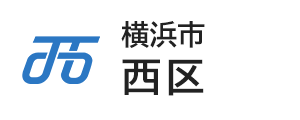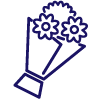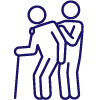Here's the text.
Let's know Kamonyama Park
Last Updated October 5, 2021
What is Kamonyama Park?
Mt. Kamon-This difficult name is read as "Kamonyama". This word is named after Naosuke Ii, the elder who contributed to the opening of Yokohama's port. Naosuke Ii was the lord of the Hikone clan, and the head of the Ii family has been called "Kamon no Kami" for generations.
It is a park that gives calm and peace of mind every season. There are playground equipment squares where many children gather and Yokohama Noh-theater, which has the oldest Noh stage in the Kanto region.
Let's know Kamonyama Park~
1 The Past and Present of Kamonyama Park
(1)A long time ago
1)Until the Great Kanto Earthquake
Until the Edo period, it was called Fudoyama on a hill facing the sea.
In the early Meiji era, the government building of foreign railway engineers involved in the opening of Japan's first railway (between Shimbashi and Sakuragicho) was built, and it was used as a railway site after opening, so it was called "Railway Mountain".
In 1884, the former Hikone feudal lords bought it and became owned by the Ii family. In commemoration of the 50th anniversary of the opening of Yokohama Port in 1909, a statue of Naosuke Ii was built and a stone water spring was donated.
It was donated to Yokohama City by the Ii family in 1914 and maintained as a Kamonyama Park. From the park, you can overlook the sea, and it seems that it was very popular as a scenic spot with a good view.
In the Great Kanto Earthquake of 1923, the entire garden collapsed, but the park became a fire zone and became a neighboring evacuation sites.

“The Liveliness of Mt. Kamon” “Yokohama Trading Shimpo July 11, 1909” (Yokohama City Open Port Museum)
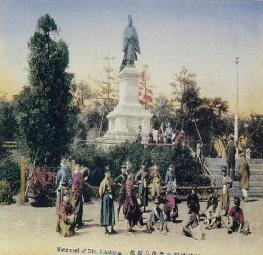
100 years ago in Yokohama, Kanagawa, owned by Municipal Central Library.
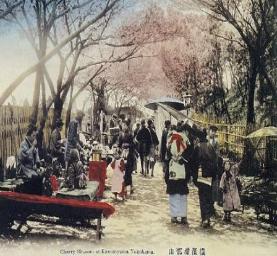
Cherry-blossom viewing at Mt. Kamon “Kanagawa, Yokohama 100 Years Ago” (collected by Municipal Central Library)
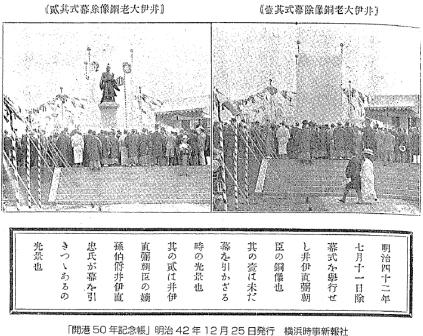
Unveiling ceremony “50th Anniversary Book of Opening of Port” (Yokohama City Opening Museum)
(2)Until the Pacific War
After the Great Kanto Earthquake, restoration work was carried out in various parts of the city, and restoration and maintenance work was carried out in Kamonyama Park. The Japanese garden in the garden was built at this time. Many trees such as cherry blossoms and pine trees were planted. In addition, local residents donated cherry blossoms and plums, and were thriving as a scenic sightseeing spot.
During World War II, the statue was recovered under the government's metal recovery instructions. Cherry blossoms were cut down as fuel, and most of the facilities and trees were burned down due to the Great Yokohama Air Raid on May 28, 1945, and the remaining ones were burned down.
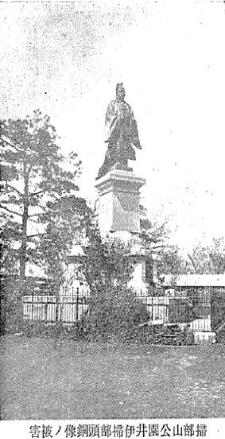
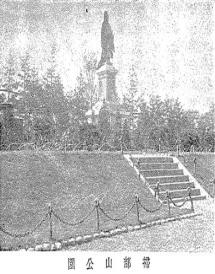
Photo of the bronze statue plaza after the earthquake, Yokohama Reconstruction Magazine Vol. 3 (in Municipal Central Library)
(3)After World War II
After the war, we planted cherry seedlings (about 80 donations from local volunteers) and shii trees and Himalaya cedars from Kishinekoen (dozens of trees), but reconstruction did not progress as expected for a few years .
At the 100th anniversary of the opening of the port in 1953, the statue was restored, maintenance and repair around the statue, tree planting, maintenance of the plaza garden path, etc. were performed, and a commemorative event was held.
It has also been used as a place for local residents such as Neighborhood Associations, and has been widely used.

“Kanagawa Shimbun-sha Yokohama Version” September 21, 1962 (Yokohama Port Opening Museum Collection)
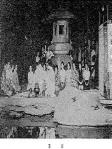
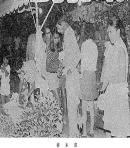
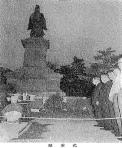
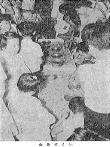
The 8th meeting to listen to the sound of insects (1972) “The Past and Present of the Nishi Ward” (in Municipal Central Library)
(4)Now
In Nishi Ward, where urbanization has progressed, it is a typical park with a lot of greenery. Cherry blossoms planted after the war grow and are known as a famous cherry blossom viewing spot. In addition, every summer, a meeting to listen to the sound of insects is held.
Yokohama Noh-theater was built in 1996. In recent years, condominium construction has been carried out around the area, and new park users are expected.
It is also a representative park in Nishi Ward, located in an area where the charms of the new and old districts (such as Kamonyama Park and Kanagawa Pref. Concert Hall gather).
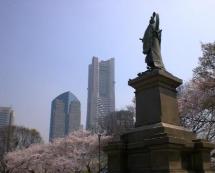
Cherry blossoms and bronze statues in recent years
2 References
(1)Yokohama Archives of History (1999) Landscape in Kanagawa Picture Postcard in Yokohama 100 years ago, Yurindo
(2)Yokohama Nishi Ward History Editorial Committee (1995) 50th Anniversary of the constituency system History of Yokohama Nishi Ward, History of Yokohama Nishi Ward History
(3)Editorial Committee of Nishi Ward (1973) Nishi Ward, Nishi Ward Tourism Association
(4)Tamura Taiji (2009) The end of the conflict and incident over the construction of the statue of Naosuke Ii, Yokohama Kamonyama Park
(5)Unknown (1938) Yokohama City Park Overview
(6)Yokohama City Hall (1932) Yokohama Reconstruction Magazine Vol. 3, Yokohama City Hall
(7)Nishi Ward History, Nishi Ward History Editorial Committee, Yokohama City (1995)
(8)Kokichi Iioka Song Monument Construction Committee (1982) Mt. Kamon Kokichi Iioka Memorial Monument Construction Prayer
Others
3 Exchange with Hikone City connected by Kamonyama Park
The development of Yokohama City began in 1859 when the opening of Yokohama Port became Japan's first trading city open to the world. The leading figure in this opening of the port was the elder Naosuke Ii.
Over time, in 1884, the former Hikone feudal lord purchased a railway mountain in Nishi Ward to build a monument to the late Naosuke Ii, and erected a statue in 1909 (50 years after the opening of Yokohama Port) 25 years later. After the statue was built, the park site and the statue were donated to Yokohama City, and now the railway mountain has been changed to "Mt. Kamonyama Park" from Naosuke Ii's official position.
Exchange between Hikone City and Nishi Ward, Yokohama City
In 1958, the year of the 100th anniversary of the opening of Yokohama Port, 1,000 people, including Mayor Hikone, Shiga Prefecture, held a commemorative ceremony in memory of Naosuke Ii at "Mt. Kamonyama Park". . After that, the exchange between Hikone City and Nishi Ward continued, and Mayor Hikone and Hikone Gun Corps performed at the meeting to listen to the sound of Nishi Ward insects.
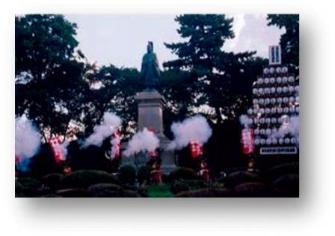
Hikone Guntai demonstration in Kamonyama Park
From now on, the exchange between Nishi Ward and Hikone will continue!
Inquiries: Nishi Public Works Office Sewage and Park Section telephone: 045-242-1313 FAX: 045-241-7582
Inquiries to this page
Nishi Ward West Public Works Office
Telephone: 045-242-1313
Telephone: 045-242-1313
Fax: 045-241-7582
Email address: ni-doboku@city.yokohama.lg.jp
Page ID: 125-214-919
